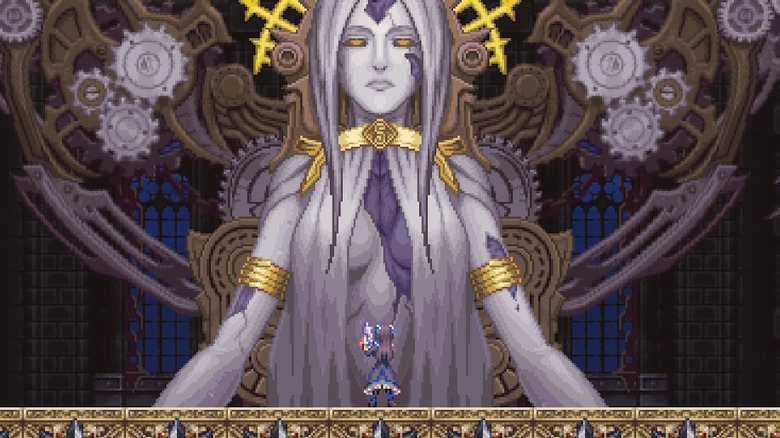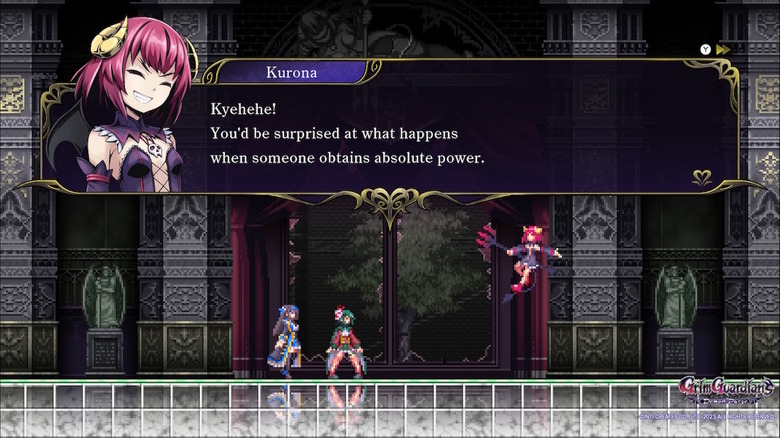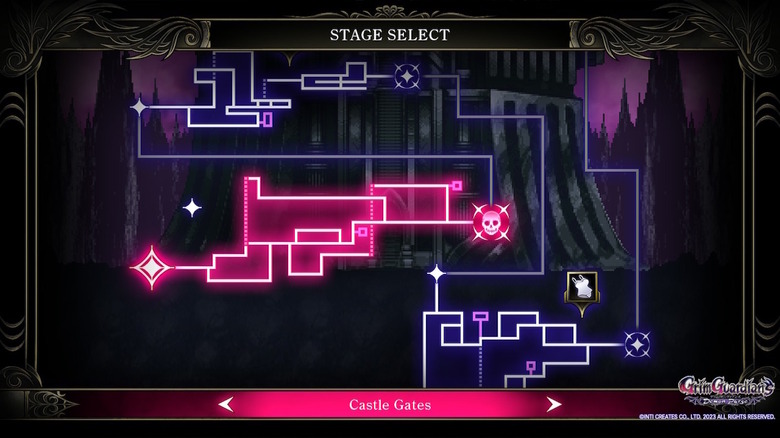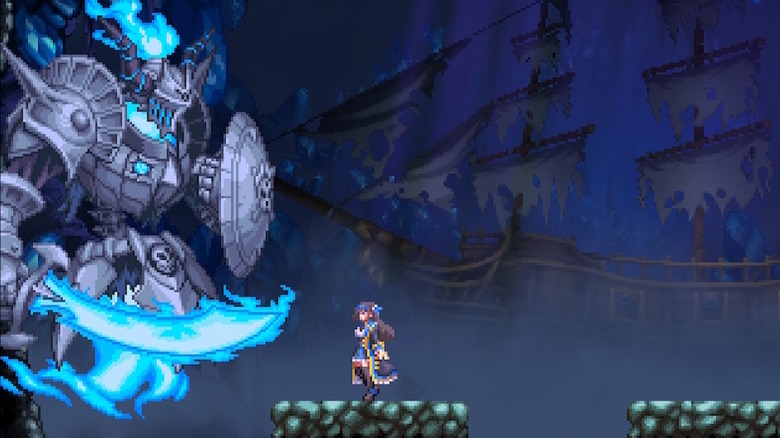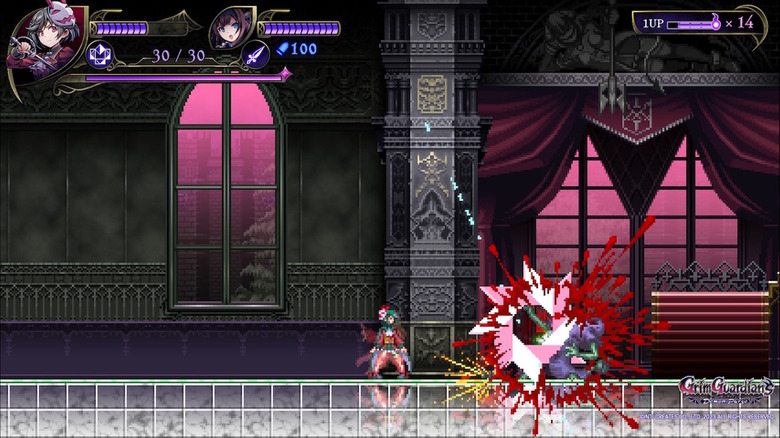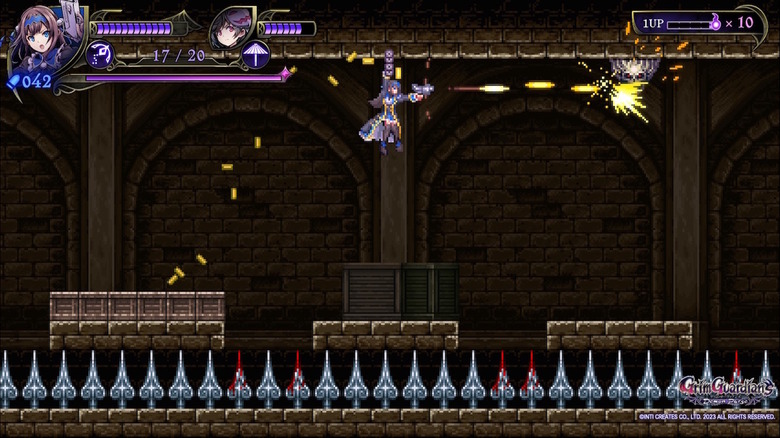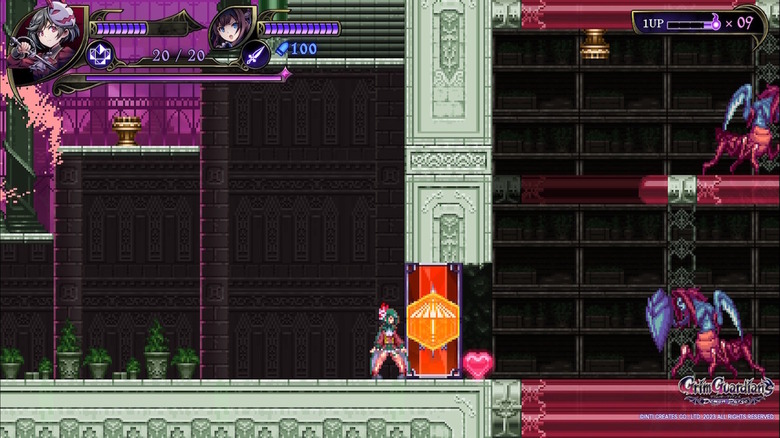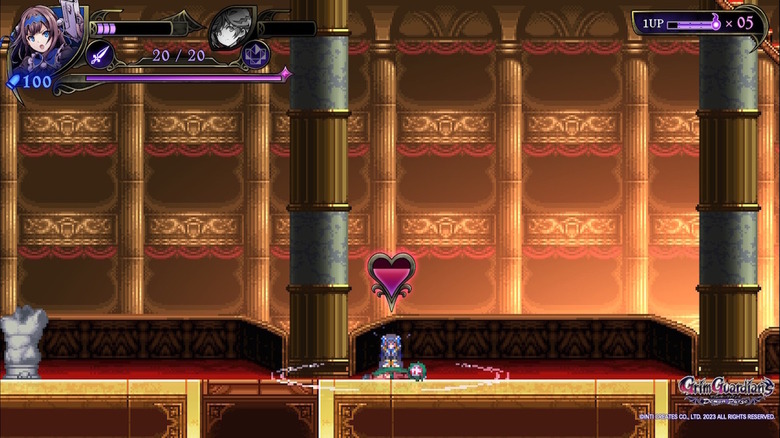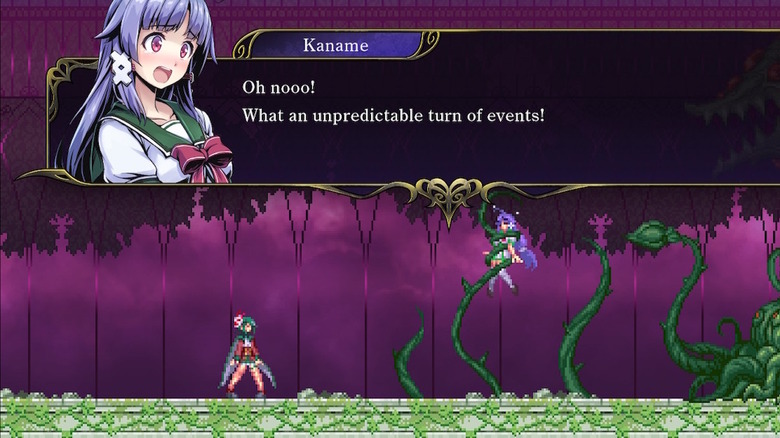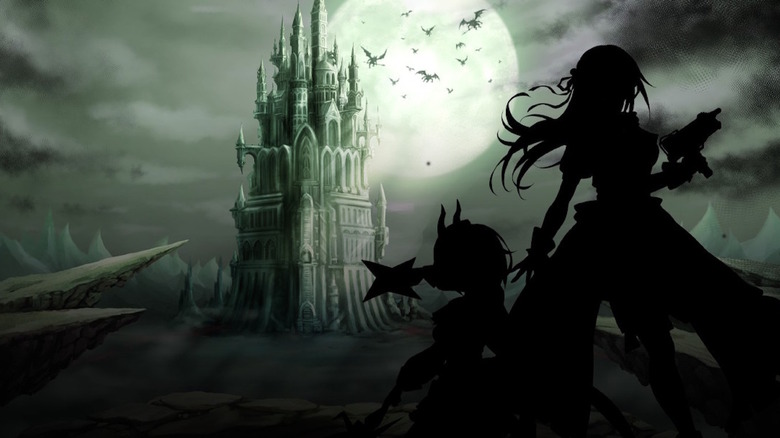Gal Guardians: Demon Purge (Switch) Review: Way Better Than Expected
- Fantastic sprite art and animations
- Plenty of worthwhile secrets to uncover
- Satisfying platforming and traversal abilities
- More depth than you might expect
- No in-game map
- Can get very difficult and frustrating
- A few moments of eye-rolling juvenile humor
My trip through "Gal Guardians: Demon Purge" has been... odd. To begin with, the game was originally called "Grim Guardians: Demon Purge," but due to a copyright claim, the developers have had to change the name from "Grim" to "Gal." You might find it on one platform as "Grim Guardians" and another as "Gal Guardians," depending on how far through the name-changing process they are.
I went in expecting something akin to "Castlevania," but with more of an emphasis on demons rather than vampires, starring a duo of anime-styled sisters who each have their own specialties when it comes to demon hunting. Turns out only my expectations for the protagonists were accurate — because this game isn't so much like new-age "Castlevania" as it is like classic "Castlevania." It'll make sense in a minute, trust me.
Point is, my initial disappointment (which was my own fault brought on by misinterpreting the release trailer) quickly gave way to excitement, because "Gal Guardians" is flipping fantastic. It certainly has its flaws, but once I figured out what it was trying to be I found myself completely absorbed in it. I wanted to keep playing because I was having fun, and when I wasn't playing I was still thinking about playing. Maybe if I go back to this one level I'll be able to figure out how to get past that door I couldn't open before. What would've happened if I'd used this particular ability in that spot I ran past?
This game is weird, silly, a little tongue-in-cheek, occasionally cringe-inducing (though nowhere near as much as I was anticipating), and gets fairly challenging. Just keep an open mind when you start it up for the first time.
High school is Hell
"Gal Guardians" follows demon-hunting Kamizono sisters, Maya and Shinobu, as they arrive for school one day to find it's been merged with the demon dimension to become some sort of large, twisted castle. Without missing a beat the pair rush in, determined to figure out what's going on, rescue their classmates, and turn the school back to normal.
Each area acts as a sort of twisted version of a part of the high school (at least that's how the game justifies it), from the entrance to the ... underground cave system? Yeah, "Gal Guardians" plays fast and loose with some of its world-building, but it usually does so with a knowing wink and nod. It's silly, but it's silly on purpose. And in some cases, it actually did manage to make me chuckle.
As the Kamizonos make their way through the school they'll sometimes run into other students who are less apt in the ways of demon hunting, so they'll need rescuing. Locating (sometimes they can be tricky to find) and saving a student like this will replenish a bit of the acting sister's health, and you can chat with your liberated classmates later on in the game once you gain access to what acts as the game's hub.
More notable students have been possessed by demons, which need to be purged in order to return them to their human forms. And some of these students are instrumental in learning and upgrading new abilities once they reach a certain point in the story.
Welcome to Castlevania
Okay, so, getting back to the "Castlevania" comparison. What I mean is that "Gal Guardians" feels less like what the series has evolved into — which is to say one big map and several unlockable abilities that eventually allow you to go back and access entirely new areas — and more like the level-based original. If you've played them before, think classic "Castlevania" instead of something like "Symphony of the Night."
This level-based approach did disappoint me at first, which I'll reiterate was my own fault, but it actually ends up working in the game's favor most of the time. You do unlock new abilities (sub-weapons that require points, similar to hearts, to use) as you complete each new area and defeat bosses. And once you've finished a level you can return to it later with your updated abilities, giving you the chance to explore more and find a secret or two.
Another benefit to splitting the game up into chunks is that there's not as much arduous backtracking. The levels aren't small, but they're compact enough to not be a bother to revisit. Plus it's easier to remember where you saw an inaccessible route when each area is a separate map with its own theme. The only real downside is there's no in-game map. You can use a compass (move the right control stick) to get a vague idea of where to head for the boss or some hidden goodies, but despite the modest level size an actual map would've been far more useful.
Drink it all in
Before I get too far into talking about the main reason you should play "Gal Guardians" (i.e. the gameplay), I need to point out just how fantastic this game looks. The character sprites are pixelated in an intentional style sort of way and straddle the line between being visually detailed and simplistic.
Every character (even the miscellaneous classmates) has at least one element that makes them look unique — mostly the hair for the other students — and the primary characters all stand out wonderfully. Then there are the demons themselves, which also have some really interesting designs and look great. But of course, the bosses steal the show since they get much larger sprites that allow for more detail.
In motion, it all looks great, too. The animations read well and when it comes to Maya and Shinobu they also add a fair bit of personality. Each sister looks distinct, moves differently (even their running animations are unique), and when paired with the (admittedly limited) voice lines they really bring the duo to life. And I was particularly impressed when I reached a windy section of the game, which showed off some really cool windblown clothing animations for both siblings — with each sister's clothes moving differently depending on whether she's facing the wind or has her back to it.
The art of demon hunting
Playing "Gal Guardians" feels just about perfect (as an action-platformer), with responsive controls and fairly intuitive button layouts. Both sisters use the same buttons to jump, attack, use sub-weapons, tag in or out, and unleash a powerful team attack — but they each also have their own nuances to take advantage of.
Shinobu, for example, excels at ranged combat with her anti-demon machine gun and an (eventual) assortment of sub-weapons that include throwing knives, grenades, a missile launcher, and more. She's great at dealing with tough enemies from a safe distance or hitting flying enemies that are out of melee range, but she doesn't hit as hard as her sister and is vulnerable up close.
On the other hand, younger sister Maya has few options when it comes to long-distance attacking but can literally chop demons into pieces face-to-face. Her smaller frame allows her to crawl through narrow areas that Shinobu wouldn't be able to reach herself, and most of her sub-weapons deal with either defense or manipulation. This is to say, she can freeze enemies to use as platforms, create a barrier to block projectiles, jump and float across large gaps, and so forth.
Neither sister is ideal for using solo 100% of the time, but when you're playing on your own you can swap between them at any time (except in mid-air, which is kind of disappointing). Falling into the rhythm of cutting through demons with Maya, then switching to Shinobu and tossing knives at flying enemies, then going back to Maya to toss up a shield and make a big jump feels fantastic. And it only gets better as more abilities are unlocked and improved.
Getting around
While it's a bit frustrating to see so many inaccessible routes when starting out, it's extremely rewarding to return with more traversal options and figure out what you need to do to finally reach them. It's all the better than, in some cases, there are actually multiple methods that can work. So if you're creative and patient enough it's possible to get through these spots a little sooner than the game may intend. Not necessarily sequence-breaking as such, but still cool to pull off.
It's often very much worth that effort, too, because there's a good chance you'll find some useful items. Some will permanently increase the sisters' maximum health, others will increase Shinobu's clip size (so you won't have to reload as often), and so on. Though to be honest these aren't as plentiful as the scattered students. You'll definitely run into them more often, but they're also a bit easier to find since you can hear them calling out for help either in the same room or from one room away.
Another unexpected but very cool wrinkle is the way you can affect the environment. Hitting (and killing) demons can get bloody, which can temporarily leave some gore behind, but in some areas said gore can actually create new hazards. Similarly, Maya's freezing sub-weapon can ice up more than just enemies, meaning she can remove some environmental hazards or create all new ones.
You're not done yet
On top of all this, "Gal Guardians" takes a not-entirely unexpected turn at one point which adds a bit more depth to the story and levels, as well as giving you the option to trade in sweets for permanent sub-weapon upgrades. These improvements aren't strictly necessary to access new locations, but they definitely make exploration and demon fighting (and your own survival) a bit easier.
Though this same turn does work against the game just a little bit. There are two difficulties to choose from at first (Casual and Veteran, with Legendary unlocking later), with the easier option providing unlimited continues, no knockback from damage, and defeated demons sometimes dropping health. On Veteran, which is what I've been playing on, enemies don't drop health items, you have limited continues (but can earn more as you play), and getting hit causes your character to get knocked backward much like the classic "Castlevania" games.
Where this becomes a small issue is when this turn I'm intentionally being vague about happens — because now things are more difficult. Some previously locked-off sections of the levels are open and are a bigger challenge than before, plus all of the bosses are back with more health, moves, and aggression. Playing through on Veteran up to this point wasn't easy, but it was perfectly manageable. Playing on Veteran in the later half of the game can be downright frustrating at times.
Tag-teaming
Up until now, I've been talking about "Gal Guardians" from a solo-player perspective, but the game does support local co-op multiplayer with one person controlling Maya and the other Shinobu. There's no swapping in co-op so there's no need to try and strategize who to change to on the fly, but at the same time that means two targets on the screen at once — and they use a shared resource pool for sub-weapons, so you have to be mindful of that.
Also in a single-player game, if you fall in combat (or into a bottomless pit), the sister you weren't using will restart at the last checkpoint and you'll have to fight your way back to manually revive (i.e. mash the X button) your sibling. In co-op there's no going back to the checkpoint — the other player just has to find an opening and revive you on the spot. And you can stand on each other's shoulders, so you can potentially give or receive a boost instead of having to utilize sub-weapon tricks to access secrets, which is nice.
Co-op does have a few issues, though. For one, if a player gets close enough to a door it'll transition to the next room, even if it happens by accident and the other person was in the middle of something. And if the sisters get too far apart, whichever one the camera decides to prioritize will stay where she is and the other will go off-screen and magically appear next to her. Understandable choices for co-op, sure, but still kind of irritating at times.
Teenagers, ugh
I touched on this briefly in the beginning but I wanted to address the ... let's go with "occasionally eye-rolling" humor that pops up from time to time. As I said, this doesn't happen anywhere near as often as I expected given the fact that this is a game built around the idea of anime-style demon-hunting high school girls (and their high school girl classmates), but it does happen. I wouldn't liken it to the worst parts of "Persona 4" or anything like that, but it can be a bit much.
Thankfully it does portray itself in a mostly satirical manner, with the sisters (and the game itself) usually making fun of tropes in a knowing manner. But for the most part, these teenagers aren't wearing embarrassingly revealing outfits and there aren't any wardrobe malfunctions. Overall it's much tamer than a lot of other similar media depicting on-par subject matter these days.
Gal Guardians: Demon Purge verdict
It's funny — when I first watched the trailer for what was then called "Grim Guardians: Demon Purge" I thought it looked like a fun action-platformer that would cater to my enthusiasm for exploration. Then I started playing it and thought I might have made a mistake after discovering the separate level structure and lack of a map. But it didn't take long for that worry to turn into enjoyment, because even though it's not what I was hoping for it's a ton of fun to play.
I'm not used to a game entertaining me so thoroughly after failing to meet my expectations, but here we are. "Gal Guardians" is pretty fun to start, and only gets more fun as more of it opens up. Sure it has its shortcomings, particularly the spike in difficulty after a certain point, but it's still a fun time, and feels great to finally push through a tough spot. Plus you can always lower the difficulty if you need to, with no penalty other than having to start from the beginning of the current level, and you can change it back again later if you want.
This is a game that's well worth your time if you enjoy the genre, and it's something I'd consider well worth the $24.99 I paid for it. And remember, it might be called "Grim Guardians: Demon Purge," or it might be called "Gal Guardians: Demon Purge," depending on how and when the creators of this game are moving through their name-changing process.
